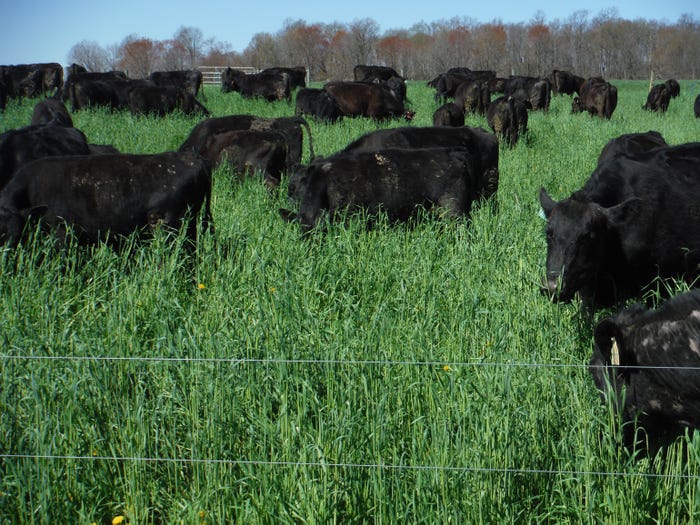
Russ Wilson hasn’t cut his grass in three years. And he likes it that way.
“I have livestock. They do that for me,” the Clarion, Pa., farmer said.
As a cow-calf operator who raises seedstock for grass-based beef operations, Wilson has found that intensive grazing and stockpiling forage is the best way for him to make it as a cow-calf producer.
Speaking at the recent Pennsylvania Association for Sustainable Agriculture Conference, Wilson talked about the system that he’s put in place on his farm that’s enabled him to pay his bills and live comfortably without having to take a second job.
Cutting costs
For Wilson, the key to his success has been his ability to phase out having to make hay for winter feeding.
In 2011, he grazed his cattle for 120 days, bought 3,500 gallons of diesel fuel, spent $2,400 on one pallet of plastic wrap to make hay and spent $26,000 of fertilizer, “leaving very little profit for me,” he said. “I want to work on the farm. I don’t want to work off the farm to support the farm.”
In 2016, he increased his farm’s grazing days to 294 and bought only 200 gallons of diesel fuel.
In the past three years his farm’s grazing days have increased to more than 300 days. Last year, his farm had 331 grazing days.
Intensive grazing
Wilson has 220 acres, of which 135 acres are pastured.
He grows 70 different species of perennial grasses, including cool-season fescues, orchardgrass, canarygrass, alfalfa, clover and others.
Using polywire fencing, he divides his acreage into 17 or 20 paddocks at the start of the season, each around 2 acres in size. As the growing season continues and the grass grows taller, he splits his paddocks again to around 40 paddocks. By the time summer rolls around, the paddocks are split again, down to one-tenth of an acre in some years. In any given year, depending on the growing season, Wilson said he uses anywhere between 600 and 1,500 paddocks, rotating his cattle up to 10 times a day.
 PROFITABLE GRAZIER: Wilson said he’s transformed his cow-calf operation from a money-losing venture into a profitable farm through cutting costs and embracing intensive grazing principles.
PROFITABLE GRAZIER: Wilson said he’s transformed his cow-calf operation from a money-losing venture into a profitable farm through cutting costs and embracing intensive grazing principles.

“I tell folks it takes grass to make grass," he said of his intensive grazing system. The amount of time his animals are left to graze depends on the type of forage being grown and the needs of the animal. “If we overgraze and make a lot of bare spots in the ground, you’re not getting the full potential of that plant. If we leave a very nice canopy, lots of grass, you’ll harvest more sunlight, have more production. Take half, leave half,” he said.
Over the years, Wilson has found ways to visually tell when a paddock’s ready to be grazed again. With orchardgrass, for example, he picks a plant and counts the number of leaves. If there are at least four leaves growing, the paddock is ready to be re-grazed again.
One question he gets from people visiting his farm is whether the system is good for the cattle. Most of his fields, he said, test out at around 12% crude protein, which he said is more than adequate for a gestational cow. That’s likely not enough for finishing an animal, but Wilson acknowledges that his system is not for everyone.
Wilson said it takes anywhere from an hour to 90 minutes a day to rotate his cattle. He has 100 head of cattle, six of which are bulls. The remainder of the cows include yearlings and 2-year-old heifers.
Stockpiling for winter
Wilson said that he sets aside about 45 acres each year for stockpiling forage, allowing the plots to grow for between 70 and 160 days for stockpiling. He usually puts cattle in the stockpiled forages when grasses start going dormant, which is usually around the end of October.
Some of his stockpiled forages get thick, with up to 8,000 pounds of dry matter per acre, he said.
His soil samples state that his soils can produce 6,000 pounds of dry matter per acre if they’re well-managed, but he said he gets between 10,000 pounds and 12,000 pounds of dry matter in some fields without using fertilizer or lime.
A lot of stockpiling recommendations, he said, suggest between 40 and 80 pounds of nitrogen per acre. He said the pastures will be greener and higher quality with that extra nitrogen, but that extra cost must be weighed by each producer.
“I find that the cows, they don’t mind being out, as long as it’s not windy, not super windy. That deep snow is actually OK for cows. They put their head down, move the snow around, they work around in a circle and reach the grass,” he said. “It is possible to graze in deep snow.”
Corn reset
In years when some of his fields are unproductive and in need a “reset” as he likes to call it, Wilson plants open-pollinated corn.
His animals get only 25 feet of corn a day, as he doesn’t want them to have the whole field.
He starts by planting corn in late June. He then broadcasts a cover crop over the corn, allowing them to grow together in the same plot.
In a test plot of Minnesota 13 open-pollinated corn with a cover crop, the ear husk provides 8% crude protein, the corn stover provides 4.7% crude protein and the cover crop provides 9.7% crude protein. The weighted average is 6.76% crude protein.
He said that weighted average is good for gestational beef cows, but that won’t make weight for finishers.
When corn grows with the cover crop, Wilson said some of fields measure 15,295 pounds of dry matter per acre. The cost is $30 a ton to establish.
“You can’t buy hay cheaper than that,” he said.
 SHARING THE GREEN: Wilson’s cattle this spring will start in 2-acre paddocks, getting smaller as the growing season moves along.
SHARING THE GREEN: Wilson’s cattle this spring will start in 2-acre paddocks, getting smaller as the growing season moves along.

Wilson said that cattle should be gradually placed in the corn to give the rumen time to switch over and eat the corn. He also said producers should check pesticide and herbicide labels as some have a 60-day wait period before livestock can eat it.
"The earlier you graze it, the more feed quality you'll have," he said of the corn.
The average daily rate gain on the farm is 1.8 pounds per day. It’s not for everyone, Wilson said, but for him it works, and it could work for others who want a potentially cheaper grazing system and have the farm setup for it.
“You as a manager, it's up to you to tell them when to graze, how long they can graze, how short to graze, where to place fence and water facilities,” he said. “We want as little living system disturbance as possible.”
About the Author(s)
You May Also Like






